Service quality ratings serve as a critical benchmark for industries, reflecting the alignment between customer expectations and operational standards. While sectors like hospitality and healthcare often achieve higher ratings due to their focus on customer experience, others, such as telecommunications, frequently face challenges in meeting these expectations. Understanding the factors that influence these ratings is essential for organizations aiming to enhance their service delivery and overall customer satisfaction.
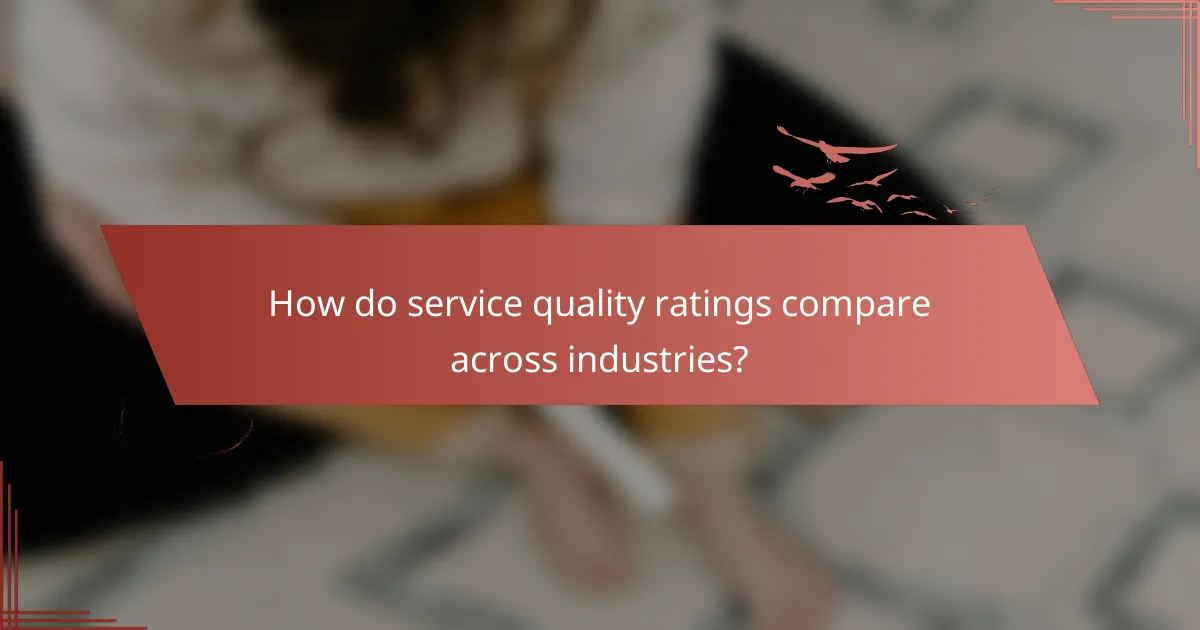
How do service quality ratings compare across industries?
Service quality ratings vary significantly across industries, influenced by customer expectations and operational standards. Generally, sectors like hospitality and healthcare tend to receive higher ratings due to their direct impact on customer experience, while others, such as telecommunications, often struggle with lower scores.
Comparative analysis of service quality ratings
When comparing service quality ratings, it’s essential to consider the criteria used for evaluation, which often include responsiveness, reliability, and customer satisfaction. Different industries may prioritize these factors differently, leading to varied ratings. For instance, a restaurant may be judged more on food quality and ambiance, while a bank might focus on transaction efficiency and customer support.
Industry benchmarks can provide a useful reference point. For example, the American Customer Satisfaction Index (ACSI) offers insights into how various sectors perform relative to one another, highlighting trends and areas for improvement.
Top industries with high service quality
Industries that consistently receive high service quality ratings include hospitality, healthcare, and retail. In hospitality, personalized service and attention to detail often lead to exceptional customer experiences, resulting in high ratings. Healthcare providers that prioritize patient care and communication also tend to score well, as patients value empathy and responsiveness.
In retail, especially e-commerce, companies that offer seamless shopping experiences, easy returns, and excellent customer service often achieve high satisfaction ratings. Brands like Amazon and Zappos are frequently cited for their commitment to customer service excellence.
Industries with low service quality ratings
Conversely, industries such as telecommunications, utilities, and public transportation often receive lower service quality ratings. Customers frequently cite issues like long wait times, poor communication, and lack of responsiveness as key pain points in these sectors. For example, many consumers express frustration with the customer service of major telecom providers, often leading to dissatisfaction.
Additionally, public transportation systems may struggle with reliability and punctuality, impacting overall customer perceptions. Companies in these industries can benefit from focusing on improving customer interactions and addressing common complaints to enhance their service quality ratings.
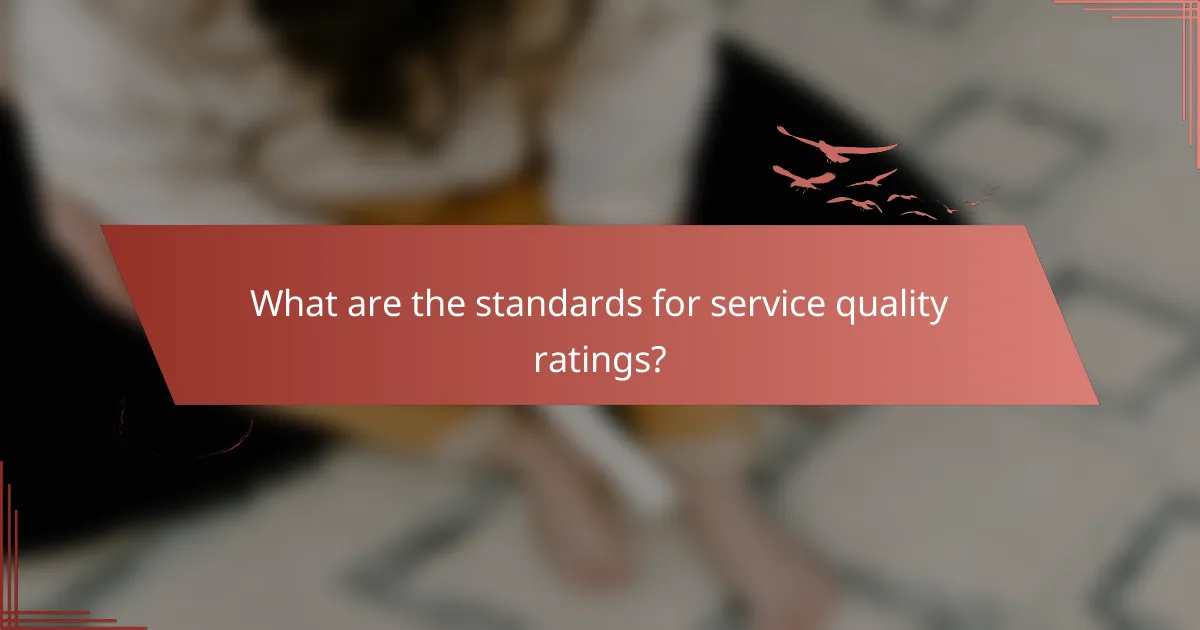
What are the standards for service quality ratings?
Service quality ratings are typically defined by established criteria that measure customer satisfaction and operational performance. These standards help organizations assess their service delivery and identify areas for improvement.
ISO 9001 standards for service quality
ISO 9001 is an internationally recognized standard that outlines the requirements for a quality management system (QMS). It emphasizes customer satisfaction, process improvement, and compliance with regulatory requirements, making it essential for organizations aiming to enhance service quality.
To comply with ISO 9001, companies must document their processes, monitor performance, and continuously improve their services. Regular audits and customer feedback are critical components to ensure adherence to these standards.
Industry-specific service quality benchmarks
Service quality benchmarks vary significantly across different industries, reflecting unique customer expectations and operational challenges. For example, the hospitality sector may focus on cleanliness and responsiveness, while the healthcare industry emphasizes patient care and safety.
Organizations can utilize industry-specific benchmarks to evaluate their performance against competitors. Common metrics include Net Promoter Score (NPS), Customer Satisfaction Score (CSAT), and First Contact Resolution (FCR). These benchmarks provide actionable insights for improving service quality and meeting customer expectations.

How do customer expectations influence service quality ratings?
Customer expectations play a crucial role in shaping service quality ratings, as they set the benchmark for what clients anticipate from a service provider. When expectations are met or exceeded, ratings tend to be higher; conversely, failure to meet these expectations can lead to lower ratings and dissatisfaction.
Customer expectations in the hospitality industry
In the hospitality industry, customer expectations often revolve around factors such as cleanliness, staff friendliness, and prompt service. Guests typically expect a welcoming atmosphere, efficient check-in processes, and high-quality amenities. Meeting these expectations is essential for maintaining positive service quality ratings.
For example, a hotel that consistently provides clean rooms and attentive service is likely to receive higher ratings than one that falls short in these areas. Establishments can enhance customer satisfaction by regularly training staff and soliciting feedback to align services with guest expectations.
Impact of customer feedback on service ratings
Customer feedback significantly impacts service ratings by providing insights into areas of improvement and strengths. Positive reviews can boost a business’s reputation, while negative feedback can highlight shortcomings that need addressing. Many consumers rely on online reviews, making it essential for businesses to actively manage their online presence.
To effectively use customer feedback, businesses should regularly analyze reviews and identify common themes. Implementing changes based on this feedback can lead to improved service quality and higher ratings over time. Additionally, responding to customer reviews, both positive and negative, demonstrates a commitment to service excellence and can enhance customer loyalty.
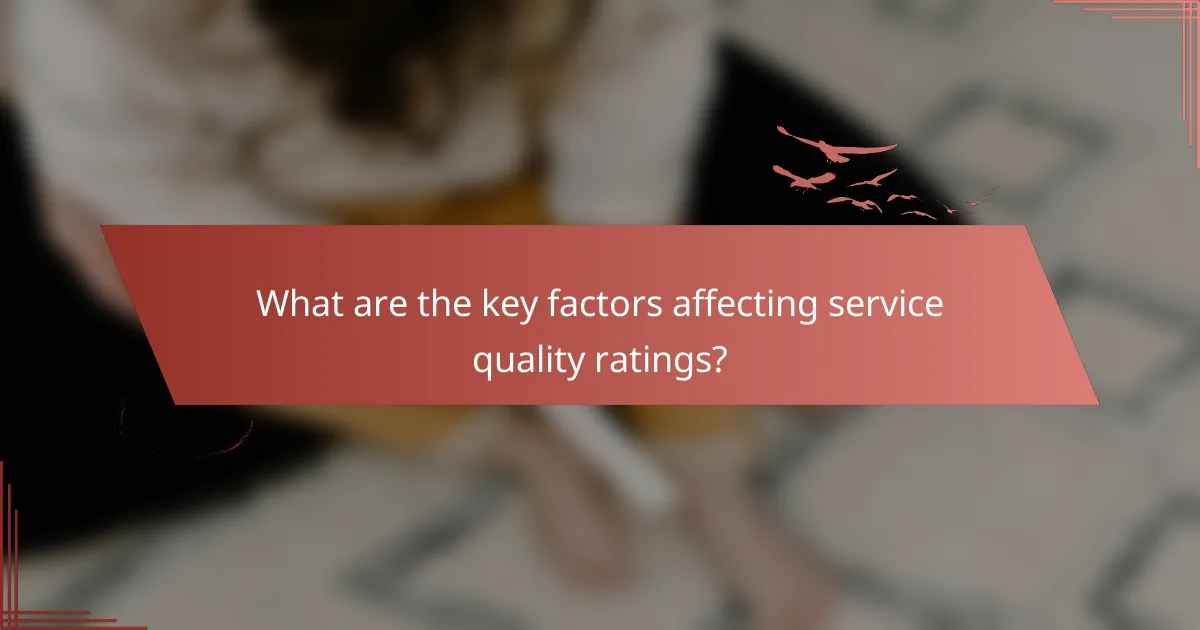
What are the key factors affecting service quality ratings?
Key factors affecting service quality ratings include employee training, technology integration, and customer expectations. These elements significantly influence how customers perceive the quality of services provided, impacting overall satisfaction and loyalty.
Employee training and its effect on ratings
Employee training is crucial for enhancing service quality ratings as it equips staff with the necessary skills and knowledge to meet customer needs. Well-trained employees are more likely to provide consistent and high-quality service, leading to positive customer experiences.
Organizations should invest in regular training programs that focus on both technical skills and soft skills, such as communication and problem-solving. For instance, a restaurant that trains its staff on customer service etiquette can see improved ratings due to better interactions with patrons.
Technology’s role in enhancing service quality
Technology plays a significant role in improving service quality ratings by streamlining operations and enhancing customer interactions. Tools such as customer relationship management (CRM) systems and chatbots can provide timely responses and personalized experiences, which are highly valued by customers.
Businesses should leverage technology to gather feedback and analyze customer data, allowing them to identify areas for improvement. For example, a retail store using a CRM system can track customer preferences and tailor promotions, leading to higher satisfaction and better ratings.

How can businesses improve their service quality ratings?
Businesses can enhance their service quality ratings by actively seeking and implementing customer feedback, refining their processes, and training staff to meet customer expectations. Focusing on continuous improvement and responsiveness to customer needs is essential for achieving higher ratings.
Implementing customer feedback loops
Customer feedback loops involve systematically collecting, analyzing, and acting on customer input to improve service quality. This can be achieved through surveys, direct interviews, or online reviews, allowing businesses to understand customer perceptions and areas needing improvement.
To effectively implement feedback loops, businesses should establish regular intervals for collecting feedback and ensure that responses are reviewed and acted upon promptly. For instance, a restaurant might send out post-dining surveys to gauge satisfaction and make necessary adjustments based on the results.
Best practices for service quality improvement
Best practices for enhancing service quality include setting clear service standards, training employees, and monitoring performance consistently. Establishing benchmarks helps staff understand expectations, while training equips them with the skills needed to meet those standards.
Additionally, businesses should regularly review service processes and customer interactions to identify inefficiencies or pain points. For example, a retail store might analyze checkout times to streamline the process, thereby improving customer satisfaction. Regularly recognizing and rewarding employees for excellent service can also motivate them to maintain high-quality standards.
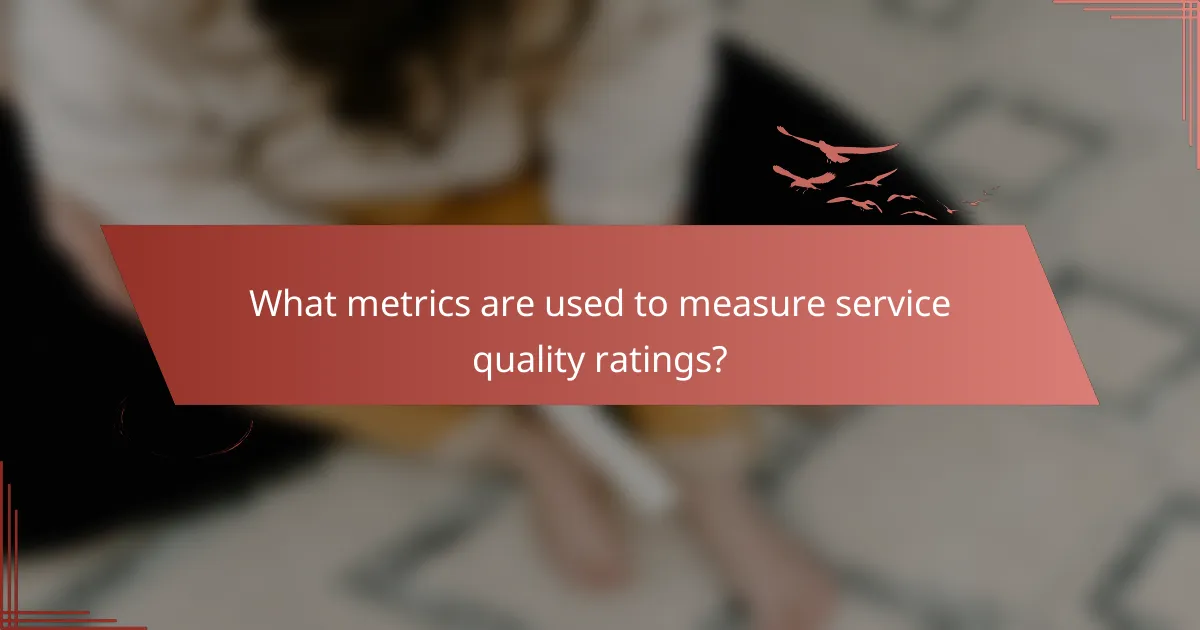
What metrics are used to measure service quality ratings?
Service quality ratings are typically measured using various metrics that assess customer perceptions and experiences. Common metrics include Net Promoter Score (NPS) and Customer Satisfaction Score (CSAT), which provide insights into customer loyalty and satisfaction levels.
Net Promoter Score (NPS) explained
Net Promoter Score (NPS) gauges customer loyalty by asking how likely customers are to recommend a service to others on a scale from 0 to 10. Responses categorize customers into promoters, passives, and detractors, allowing businesses to calculate their NPS by subtracting the percentage of detractors from the percentage of promoters.
A high NPS indicates strong customer loyalty, while a low score suggests areas for improvement. Companies often aim for an NPS above 50, which is considered excellent, but this can vary by industry.
Customer Satisfaction Score (CSAT) overview
Customer Satisfaction Score (CSAT) measures how satisfied customers are with a specific interaction or overall experience. Typically, customers rate their satisfaction on a scale from 1 to 5 or 1 to 10, with higher scores reflecting greater satisfaction.
CSAT is useful for identifying immediate issues and understanding customer sentiment. A CSAT score above 80% is generally seen as favorable, but businesses should consider industry benchmarks for context. Regularly collecting CSAT data can help track improvements over time and inform service adjustments.
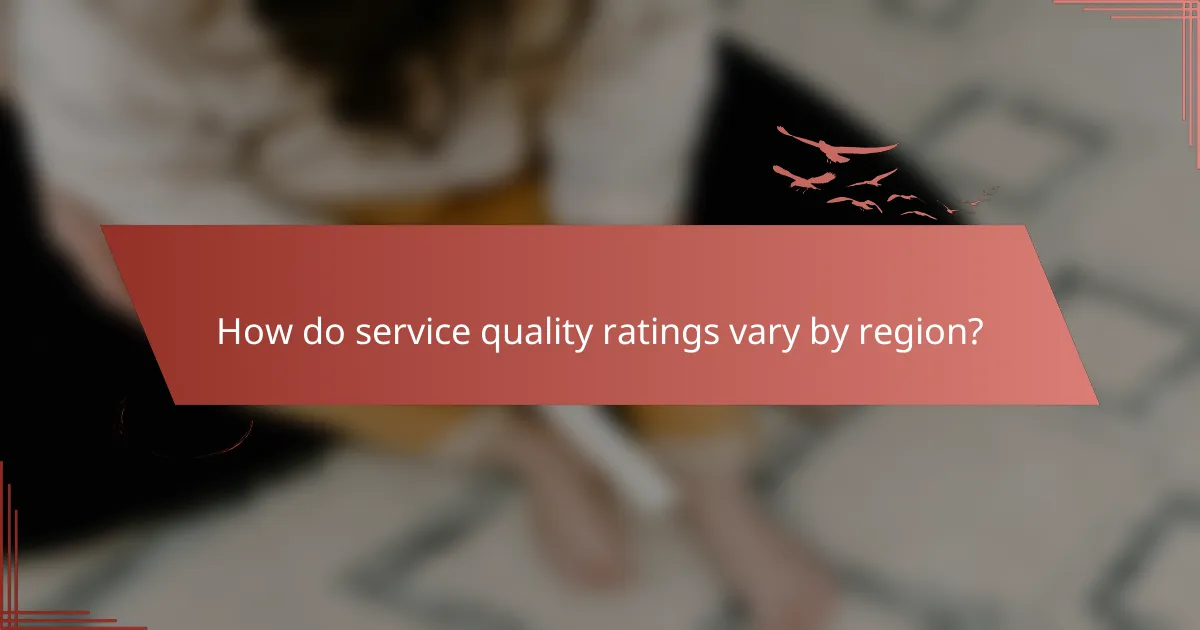
How do service quality ratings vary by region?
Service quality ratings differ significantly across regions due to cultural expectations, industry standards, and customer preferences. Understanding these variations helps businesses tailor their services to meet local demands effectively.
Service quality ratings in North America
In North America, service quality ratings are often influenced by customer-centric practices and high expectations for responsiveness. Businesses typically aim for ratings above 80% in customer satisfaction surveys, reflecting a strong emphasis on service excellence.
Key sectors such as hospitality and retail prioritize quick service and personalized experiences. For instance, restaurants often strive for prompt seating and attentive service, while retailers focus on knowledgeable staff and efficient checkout processes.
Service quality ratings in Europe
European service quality ratings can vary widely by country, with Northern European nations generally scoring higher in customer satisfaction compared to Southern Europe. In countries like Sweden and Denmark, service quality ratings frequently exceed 85%, driven by a commitment to efficiency and professionalism.
In contrast, Southern European countries may prioritize relationship-building and hospitality, leading to different service expectations. For example, in Italy and Spain, customers may value a friendly atmosphere over speed, which can affect overall ratings.
